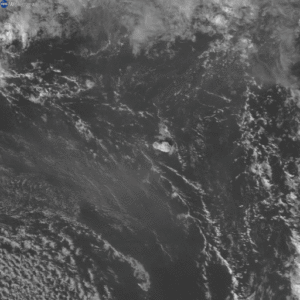On Saturday, an enormous eruption on the volcanic islands of Hunga Tonga and Hunga Haʻapai shook the Pacific Ocean. The explosion, which could be heard six thousand miles away in Alaska, caused tsunamis across the entire ocean—including nearly 50-foot waves in Tonga—and was visible from space thanks to its enormous ash cloud and powerful shockwave. But the volcano also caused another, less visible disturbance: a massive rippling of atmospheric gravity waves that spread thousands of miles from the site of the eruption—and which was detected thanks to supercomputing at the Jülich Supercomputing Centre in Germany.

Lars Hoffman leads the Simulation and Data Laboratory (SimLab) for Climate Science at Forschungszentrum Jülich (FZJ). “We have two tasks,” he told HPCwire in an interview. “We have support tasks—so we help people who want to use our supercomputers to run their climate codes or numerical weather prediction codes … and on the other hand—and the other 50 percent of our time—we are free to do research activities we are interested in.”
For Hoffman, that often means atmospheric gravity waves, which occur when air columns are vertically disturbed. Some 15 years ago, Hoffman—while working in Boulder—developed a radiative transfer model and analysis codes for the extraction of gravity wave observations from Earth observation instruments. The interest persisted through his work with FZJ, leading, several years ago, to the development of a tool for near-real-time processing of satellite gravity wave data.
“And then, just this weekend, these colleagues from the UK … noticed the eruption and they asked the question: would this trigger gravity waves in the stratosphere?” Hoffman said.
Detecting gravity waves in the atmosphere
“Basically, what we are doing is: we continuously download the operational radiance measurements from NASA data servers,” Hoffman said. “To get you an idea of the amount of data, over this 20 years of data, it’s something like 200 terabytes. So it’s not extremely much data, but it’s some data for us to deal with.”
“The next step then is to run the codes—to extract gravity wave information from the radiance measurements,” he continued. “So we have, basically, some C codes and some scripts for doing this, and this has been set up in a way that we regularly launch compute jobs on the supercomputers in Jülich.”
The supercomputer in question is the Atos-built JUWELS cluster module, part of the massive supercomputer at Jülich that still stands as the most powerful publicly ranked system in Europe. The cluster module, weighing in at more than 2,500 nodes, leverages more than 5,000 Intel Xeon CPUs and over 270 petabytes of memory to deliver 6.2 Linpack petaflops of performance. (Its sister module, the JUWELS booster, is GPU-based and delivers 44.1 Linpack petaflops—but, Hoffman said, the gravity wave codes have not yet been ported to GPUs.)
So, on a regular basis, a virtual machine operated by Hoffman’s team at Jülich downloads the new data, initializes the compute jobs on JUWELS, and delivers the resulting data to a front-end interface for researchers and other users.
Analyzing the Tonga eruption
“Here, we are really looking at gravity waves in the stratosphere,” Hoffman said. “So these are infrared measurements from spectra from the atmosphere which get optically thick at 30 to 40 kilometers of altitude. So we don’t see anything on the ground—we don’t see clouds or something. We just see temperature fluctuations in the air.”
These fluctuations, he said, are distinct from the soundwaves seen propagating in the animation above. “Gravity waves are present in the stratosphere from many sources,” he explained. “They can be triggered, for example, by storm systems, from latent heat release in the atmosphere or from airflow over mountains, which would cause oscillations in the atmosphere.”
“And here,” he continued, “the volcano—most likely, the hot ash from the volcano—is the source which is triggering the gravity waves. Usually for the other types of [gravity] waves we see in the atmosphere, they spread maybe a few hundred kilometers or so[.] Here, for this strong source from the Tonga eruption, it shows that the horizontal propagation distance is up to 10,000 kilometers. So in this sense, it’s really unique. We’ve analyzed almost 20 years of satellite data, and something like this was not seen before.”

Volcanoes are usually interesting to earth and climate scientists for a variety of reasons, including the deposit of sulfur dioxide into the atmosphere from a volcanic eruption, which can sometimes have a substantial cooling effect on the regional or global climate. (This, too, is a subject of study for the Climate Science SimLab.)
“In the short term, I think we want to understand what waves are triggered by the volcano, what are their characteristics, and how active the volcano is [as] a source of the gravity waves,” Hoffman said. “But I think in a longer term—some months or years, probably—this could be something like a natural experiment for atmospheric models to test their high-resolution numerical weather prediction codes, or [for] climate models, to see if they can reproduce such an event in their models.”
“I think,” he concluded, “it will keep us busy for a long time.”
And with FZJ expected to be a major contender for one of EuroHPC’s forthcoming exascale systems, he’ll likely have a lot of computing power at his disposal.



























































